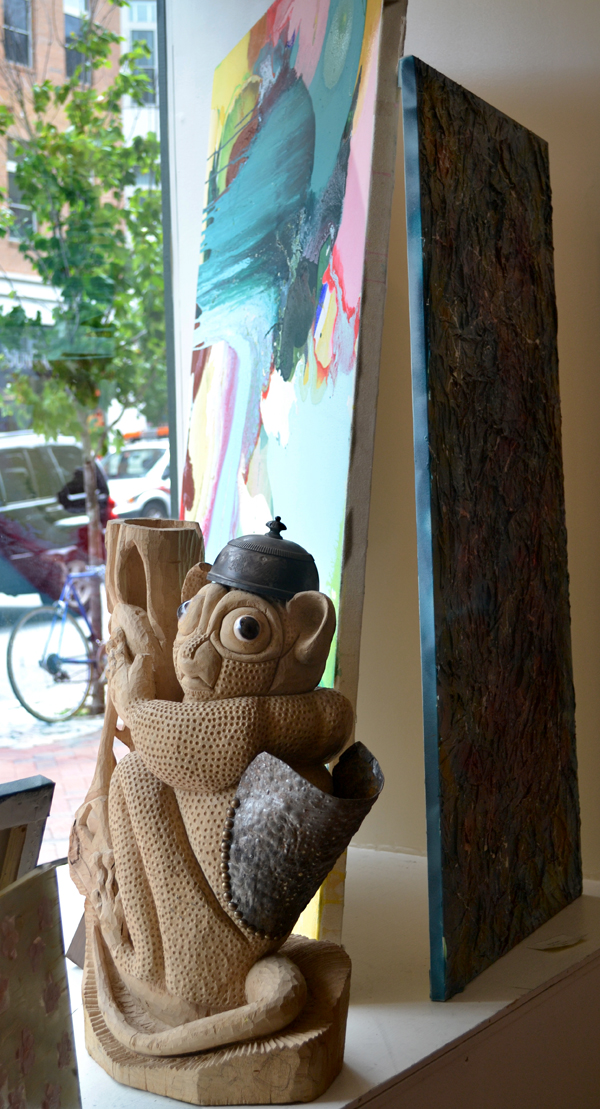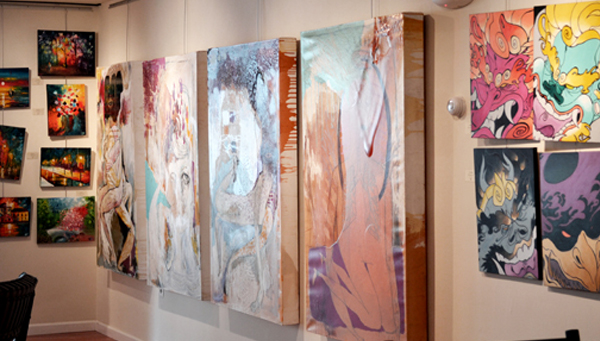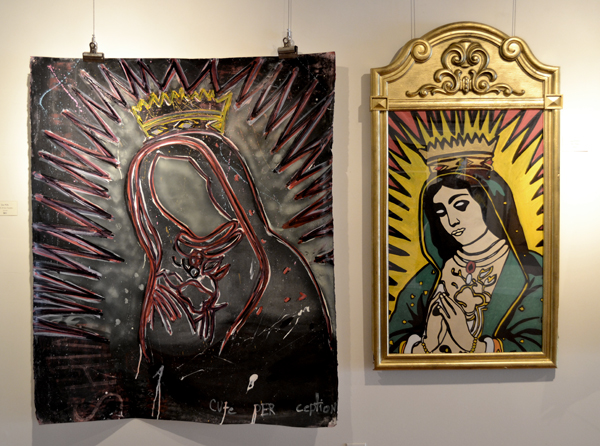Cakewalk Gallery: Q&A with its director
A new gallery on North Charles Street is big news. This is a city bursting with artists with too few venues, especially storefront ones on what was Baltimore’s premier commercial street. Only the venerable C. Grimaldis Gallery in the 500 block has opened (1977) and survived. I know. I’ve exhibited in three that didn’t.
When I first spied the Cakewalk Gallery (http://www.cakewalkgallery.com/) while walking the dog, my first thought was: “Running a gallery ain’t no cakewalk.” My second thought was to check it out. And my first impression as I walked by (I didn’t go in because of my pooch) was: The stuff is pretty amateurish. Lots of color, little substance. Yet since it takes so much hutzpah to open a gallery, I wanted to talk to the owner. Who was this person(s) and why is he/she doing this? Fortunately Adam ***, the director, agreed to meet and allowed me to take photographs and to conduct this interview via email. (I agreed to delete the name of the gallery director in December 2014 at the individual’s request)
Adam with paintings by Okan Arabacioglu, one of the more accomplished artists at Cakewalk.
What motivated you to open a gallery?
I’ve always had an appreciation of and an interest in art. Knowing a number of emerging artists, I know how difficult it is for them to get exposure in galleries and wanted to create a space where I could exhibit their work to the public and give them much needed exposure to help support their work and hone their craft. Simultaneously, I wanted to provide the public with a laid back and comfortable atmosphere to purchase works of art. For those just starting out with collecting, galleries can present an intimidating front if you know little about the art world and people can be nervous about choosing the “wrong” piece. Some commercial galleries I’ve been to have the atmosphere of a used car dealership with high pressure sales tactics, replete with spiriting you away to a “private viewing room” where they aggressively tout the investment value of pieces and how the art will repay you with monetary rewards. I believe these tactics to be distasteful and borderline unethical as they prey on people. At others, the price range of more established artists is out of the range of many consumers. I wanted to remove these concerns to help the public focus on the most important reason to purchase art: finding a piece that speaks to you on a personal level. What I, the artist, or any art critic thinks of the piece is irrelevant in the long-term ownership of a work of art as the one who will have it as a part of their life is the end consumer. This was part of the philosophy behind the choice of the name Cakewalk Gallery. While owning and operating it certainly hasn’t been a cakewalk, I hope to create an easy, enjoyable environment for both the artists and the public in which to appreciate and acquire works of art to enrich their lives.
Are you doing this by yourself financially or do you have backers?
I’ve opened the gallery on my own and have no other financial backers.
What did you do professionally before opening Cakewalk Gallery?
My prior background was in government contracting. It is a major but welcome career change.

Paintings by Jason Tompkins (left) and drawings by David Roesner (right)
Why did you pick to open a gallery where you did?
For one, I love Mount Vernon and the surrounding area. I live in the neighborhood and am pleased to see a number of the vacant storefronts filling in with small businesses. While there are other areas in the city that I also enjoy, I wanted to help spur the growth in my home neighborhood and felt the many nearby arts-related institutions would be good neighbors.
How much work and time did it take before you could open your doors?
I spent roughly three months fixing up the space before we opened. I also spent about six to twelve months prior to signing the lease researching the industry, visiting other galleries in the area, speaking with artists, and reading up on general requirements of operating a small business in Baltimore City.
What background do you have in the arts?
While I have no formal arts training or schooling, I’ve always enjoyed collecting works of emerging artists and visiting museums, art shows, and commercial galleries. I occasionally dabble in painting myself but am my own worst critic and certainly wouldn’t put my own works up for sale. If I did, I wouldn’t be open very long!
(Left) Paintings by Jason Mullan
What philosophy guides you in choosing what artists to exhibit?
I have several deciding factors when choosing artwork to exhibit. I pick works that I feel speak to the viewer and are appealing to the general public. I also try to ensure we have a good mix of pieces of varying mediums, styles and subject matter in order to keep an eclectic environment. I’ve focused mainly on emerging artists who haven’t been exhibited at many (or often any) juried shows or more formal settings. While I am constantly bringing in new work and varying our exhibiting artists, some names that you are likely to see here are David Roesner, Aaron Craven, Jason Tompkins, Ash Hussein, Jason Mullan, and many others. Among the things that catch my eye are interesting subject matter and an artist’s ability to show variety and growth through use of varying materials and techniques in creating their work.
What type of patron and pocketbook are you trying to serve? Is there a price range you try to stay within?
I generally focus on pieces that are affordable to the general public. Too often art collecting has been seen as the domain of the upper- and upper-middle classes. In these hard economic times I want to help average people to enrich their lives with art without having to stretch their budget. While there are some outliers, I generally try to keep the retail price for the bulk of our pieces under $1000 and as much as possible under $500. Factoring in the many years of enjoyment a piece can bring to a home or office, these price ranges are a bargain for one of a kind original artwork, often being cheaper than the mass produced images sold at big box stores.
One of your artists shows giclee-produced images. Is that a legitimate medium for an art gallery? Why? Are you planning to produce giclee images in-house?
While the vast bulk of our pieces are one-of-a-kind originals, we do accept giclee and print images from artists. This medium is one way to bring the price of otherwise more expensive works down to a level affordable by almost anyone, particularly if done in an unlimited edition. The technology to produce pieces in this medium has advanced so much in the last few years that, from a distance of several paces (often the viewing range in most homes or other areas of display), it would be difficult to impossible for the untrained eye to distinguish them from an original. Quality canvas giclees stretched over a frame are durable and will last a lifetime with no visible color fading. The other main advantage giclees offer is to the artist. Once scanned or photographed, the artist can store the image for later use as needed. This negates the need for the artist to maintain massive inventories of pieces whose upfront cost has already been spent but which aren’t collecting revenue. This is particularly helpful to emerging artists operating on a shoestring budget as it allows them to have a broad range of options for customers without the high upfront cost of stockpiling inventories. I don’t have imminent plans to produce giclee images in house but am definitely keeping the possibility open to give our affiliated artists other options to sell their work as well as to make our otherwise affordable items even more affordable to a wider audience.
Are you planning one-person shows? Are you planning shows around particular themes? Are you looking for outside curators?
Due to the gallery’s large size and efforts to focus on a lower price range, it would be difficult to impossible for us to have one artist with enough works to sell to fill the entire gallery and cover our costs of operating. For example, we currently have well over 100 pieces on display. I am open to doing themed showing, but this most likely would be limited to sections of the gallery, rather than the entire thing, for the reasons just mentioned. I am not currently looking for outside curators.
Sculpture by Art Palmer (right)

Would you rent your gallery space to outside curators, gallery directors, or artists?
I would definitely be open to this possibility but would obviously have to know more specifics from the individuals involved before I’d commit to any arrangements. I do currently rent out the space for both private and public functions and have been approached by artists about renting out the space for one day or limited time events.
Besides sales, how would you measure whether your gallery is a success or not?
While it’s too early to tell as I’ve only been open a few months, several factors would play in my ultimate decision about the success of the gallery. First and foremost I’d hope the public would gain a greater awareness of and exposure to emerging artists who otherwise might not have had an opportunity to exhibit their work. I’d also like to have satisfied customers who enjoy the works they’ve purchased for many years to come. Another factor would be if the gallery was a positive addition to the Mt Vernon neighborhood and helped further redevelop this vibrant community.
SOME THOUGHTS
It’s one thing to want to offer affordable artwork to “everyday” people (a very commendable desire, considering how museums and some galleries can make art so unapproachable) and another to offer substantive art at reasonable prices. (This city has loads of skilled, often quite experienced artists who would be willing to offer work up under Cakewalk’s $1,000 ceiling.) It’s one thing to give untested artists exposure; it’s another thing to hang work that’s not ready to be shown. It’s one thing to offer many works of several artists; it’s another to hang a literal jumble of work. (I think the space is big enough – especially if some temporary/moveable walls were put up – to offered two or three artists one-person shows and still have miscellany in the back.)
I don’t want to sound negative. Adam’s intentions are quite commendable. I applaud his audacity. I hope Cakewalk survives long enough to fulfill some of his goals. He just needs, in short, a little professional experience to guide him.
ADAM REPLIES
I find your comments to be helpful, even if the end judgment itself a bit harsh & premature. Again, we’ve only been open a few months, so it’s rather difficult to start straight off the bat with talented artists and a completely smooth operation. Many truly talented artists won’t exhibit until you’ve been open for some time as they don’t want to be affiliated with a fly-by-night gallery, and many that do approach me are well out of the price range I hope to stay within. It can be a catch-22, so, as a result, I have to work with the material I’m presented until I’m around long enough to attract better talent. Since the artists pay a small monthly showing fee to occupy the space, I’d rather have some amateur work on the walls for a few months than dozens of square feet of vacant, unfilled space (a mark of death for retail stores). Besides, the more amateurish pieces that I do accept are dirt cheap and people still buy them which has helped stabilize my revenue stream. In fact, for better or worse, they buy way more of them than the more artistically involved pieces, which tend to languish on the walls unnoticed by the bulk of customers. After I am open a bit longer and get more artists approaching me to display work, I expect the quality of pieces to increase.
Also, it’s rather difficult to do large, one-person shows if the better quality artists approaching me don’t have the volume of material to pull them off. I expect this to change as time goes along and our artist pool gets bigger and better. The gallery is situated in a rather pricy commercial area. As a result, to keep our cash flow steady and our doors open and still sell the bulk of pieces in the price range I’m seeking, I need to keep a rather large inventory and a very steady stream of sales. There’s a reason why many art galleries pop open and then shutter their doors shortly after: Opening a gallery in a nice area requires a large inflow of cash on a regular basis to pay the hefty bills. Unfortunately, there is a tradeoff between doing what is artistically most desirable and what is financially feasible. Just because it’s an art gallery doesn’t mean it operates outside of the realm of financial reality and is exempt from the rules other businesses are required to follow. Even though money wasn’t my primary focus for opening this place, it still needs to be managed if I’m to keep the space open.
Trackback URL: https://www.scottponemone.com/cakewak-gallery-qa-with-adam-schadt/trackback/














